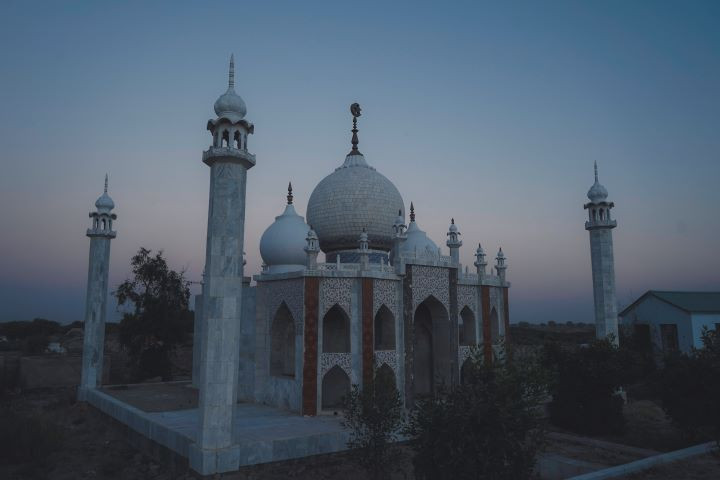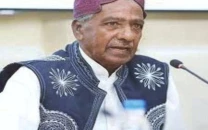An ode to husbandly love immortalised in stone
Like Shah Jehan’s for Mumtaz, Pali’s Mahal tells a story of devotion beyond life and death

Love is known to bestow the greatest of inspirations. Yet however, history is rife with many tales where it is the tragedy behind the loss of a beloved which grants the inspired the will to give his muse a tangible manifestation.
This has, throughout time, yielded innumerable sonnets, several paintings and some of the most remarkable structures the world has ever laid eyes upon. But where the artistry behind these symbols is revered in the pages of history, it is the story at their helm which separates them from any other work. Without the story, they could just be any other sonnet; any other painting; any other edifice consigned to oblivion.
From Umerkot with love
Perhaps so is why Shah Jehan’s Taj Mahal, built in the loving memory of his Empress consort Mumtaz Mahal, has held its place in time as an unmatched symbol of endearment; continuing to inspire generations of lovers to date.
One such devotee of love is 62-year old Rasool Bux Pali from Umerkot, district of Sindh. To whom, immortalising the memory of his partner meant erecting the very structure they’d once marveled together, on her gravesite.

“There is no comparison between my version of the Taj Mahal and the one in Agra, yet both are aimed at proclaiming love,” the 62-year old told a foreign news service in an interview.
The story of Pali and Maryam goes back to 1977, when the two would-be lovers tied the knot in an arranged marriage situation. “I was barely 18 at the time and Maryam was pushing 39. The almost 21-year difference between our ages made our marriage quite striking for many, but all I really remember is how fond we grew of each other over the years and the many priceless moments we shared in our lifetime together,” the Shah Jehan of Umerkot told The Express Tribune. “It was a different time back then. Women weren’t to be seen outdoors. But even then, we would make getaway trips to Hyderabad every weekend to watch movies in the cinema,” he added.
For Pali, Maryam’s companionship was his saving grace. “I was a different man before I met her. I was young, penniless and had turned to a life of drug addiction, spending days and nights loitering purposelessly on the streets. Maryam on the other hand, came from money. She brought with her 250 acres of agricultural land. With her support, I was able to quit addiction and get myself a degree in political science and another one in law. I was never rich myself, but we lived a wonderful life right down her last breath,” he recalled.
In 2015 Maryam suffered a terminal heart attack, which ended up taking her life. Left behind was a mourning lover, to whom, after four decades of marriage, a life without his inamorata seemed incomprehensible. “It was like we had 40 beautiful years together and in a blink it was all gone. I had to salvage it, but I did not know how until I recalled a dream I’d had,” said Pali as his voice quivered.
Maryam was put to rest at her husband’s family graveyard. The dream Pali had took him to Agra in 1980, when the two had first laid eyes upon the Taj Mahal and marveled at its beauty and the story behind it.
“We would sit in the Mahal’s garden and talk about Shah Jehan’s love for his wife for hours, little did we know back then that the symbol of the Emperor’s love would inspire mine someday. It was like our story was coming full circle, so it just felt right,” the 62-year old said.
Where Rasool Bux Pali now knew exactly what he was going to do to immortalise his story, unlike the emperor however, Umerkot’s Shah Jehan had a family to convince and limited resources to work with.
According to Pali’s eldest son Nasir, who had accompanied his parents to their first trip to Agra, his father’s decision to build a Taj Mahal-like structure at their family graveyard had sparked many grievances among his community. “No one wanted it to be built, but like the rest of his life, my father turned a blind eye to what all the villagers had to say about his devotion to his wife. They’d always referred to him as his wife’s servant, but my father continued to call my mother his queen. She was the matriarch of our household and we were committed to honouring her legacy,” expressed Nasir.

Talking about how he turned his dream into a reality, Pali shared that much of the construction has been incremental and it’s still a work in progress. “I acquired the services of a local mason and it has cost me almost 1.2 million rupees so far. There is yet a lot left to do, but I plan to beautify it further with time and more resources,” he told The Express Tribune.

Photo Credit: Manoj Genani



















COMMENTS
Comments are moderated and generally will be posted if they are on-topic and not abusive.
For more information, please see our Comments FAQ